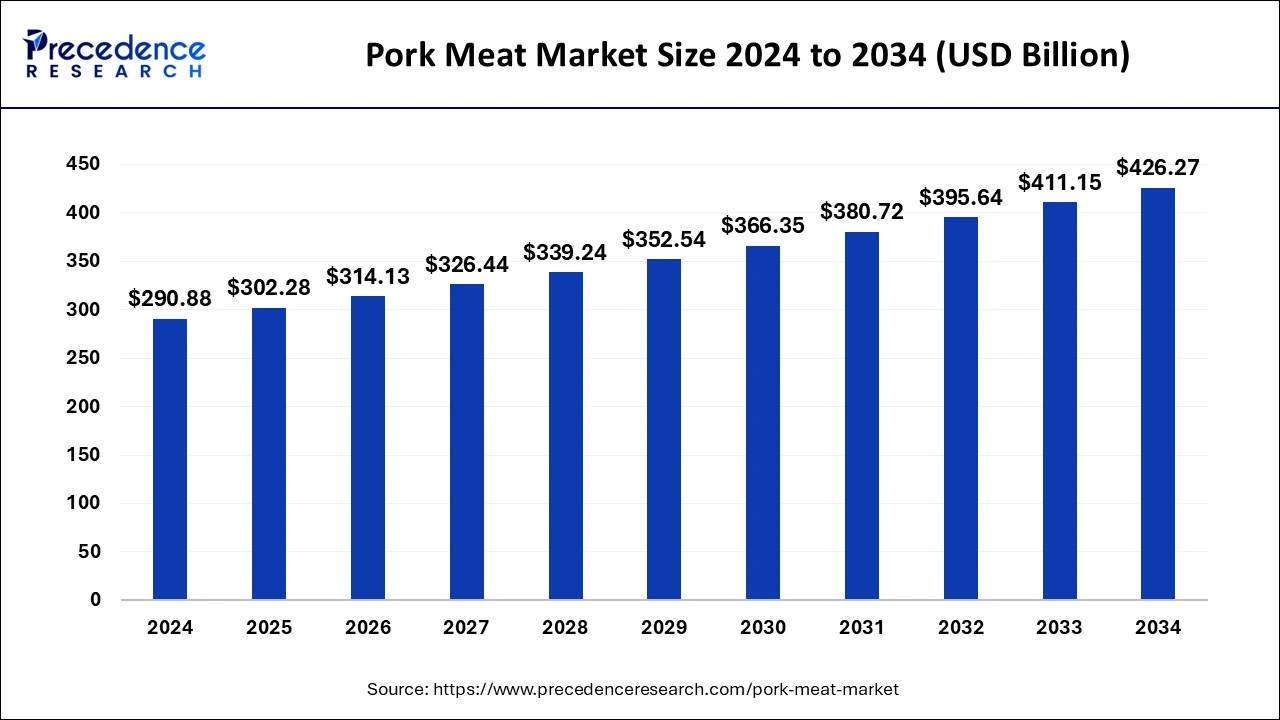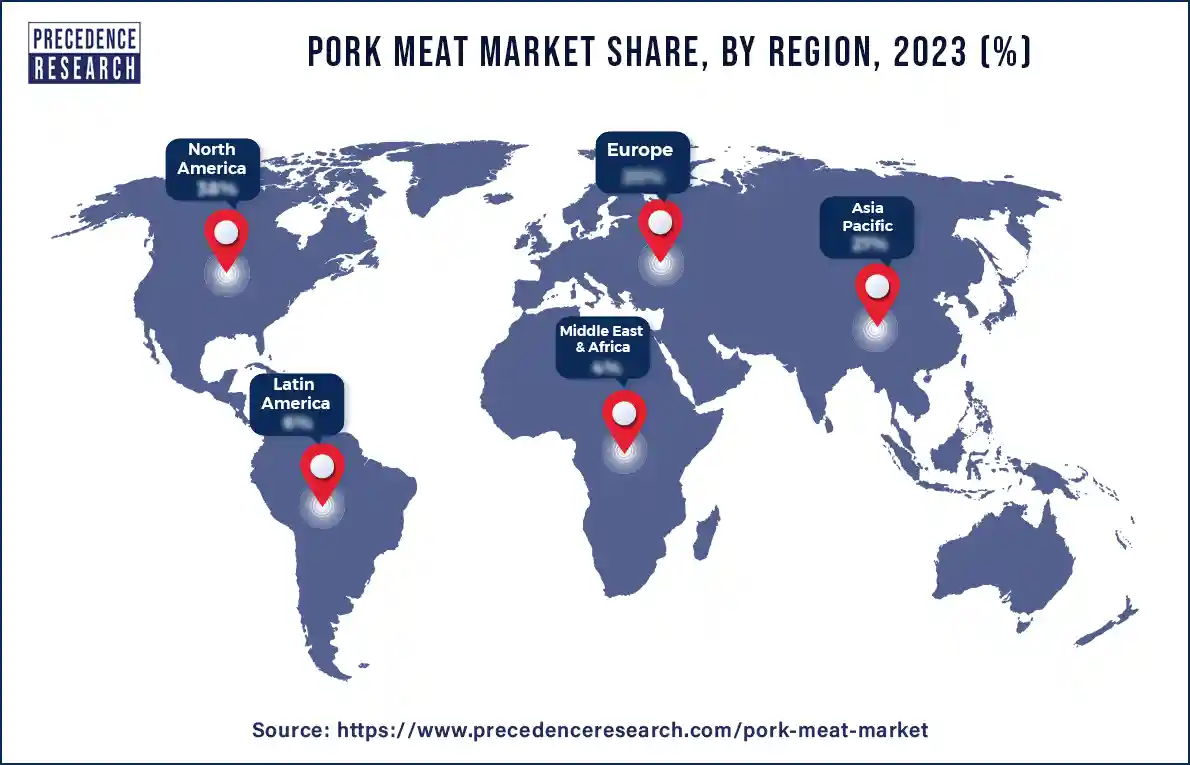September 2024
The global pork meat market size is accounted at USD 302.28 billion in 2025 and is forecasted to hit around USD 426.27 billion by 2034, representing a CAGR of 3.90% from 2025 to 2034. The market sizing and forecasts are revenue-based (USD Million/Billion), with 2024 as the base year.
The global pork meat market size was calculated at USD 290.88 billion in 2024 and is predicted to increase from USD 302.28 billion in 2025 to approximately USD 426.27 billion by 2034, expanding at a CAGR of 3.90% from 2025 to 2034. Rising disposable incomes in developing and developed countries have significantly changed people's eating habits as they tend to satisfy their test buds, which is the major driving factor of the pork meat market globally.

The pork meat market continues to show resilience and growth, driven by increasing global demand for protein-rich diets. Despite challenges such as disease outbreaks and fluctuating feed costs, the pork industry remains robust, buoyed by technological advancements in production and processing. Consumer preferences for healthier, sustainable, and ethically sourced meat options have influenced the market dynamics, prompting producers to adopt more transparent and environmentally friendly practices.
The rise of alternative protein sources has led to innovation in pork products, with companies exploring plant-based and lab-grown alternatives to meet evolving consumer demands. International trade agreements and geopolitical factors play a significant role in shaping pork meat market landscape. Changes in tariffs, import/export regulations, and disease outbreaks in major pork-producing countries can impact global supply and demand dynamics, influencing prices and market trends.
Overall, while the pork meat market faces various challenges and uncertainties, it remains a vital component of the global food industry, with emerging opportunities for growth and innovation driven by shifting consumer preferences and technological advancements.
| Report Coverage | Details |
| Growth Rate from 2025 to 2034 | CAGR of 3.90% |
| Market Size in 2025 | USD 302.28 Billion |
| Market Size in 2024 | USD 290.88 Billion |
| Market Size by 2034 | USD 426.27 Billion |
| Largest Market | Asia Pacific |
| Base Year | 2024 |
| Forecast Period | 2025 to 2034 |
| Segments Covered | Type, Packaging, and Application |
| Regions Covered | North America, Europe, Asia-Pacific, Latin America, and Middle East & Africa |
Demand for a protein-rich diet
One major growth driver of the pork meat market is the increasing global population coupled with rising savings. As the world's population continues to grow, particularly in emerging economies, the demand for protein-rich diets, including pork, is on the rise. With higher incomes, more people can afford to include pork in their diets, leading to increased consumption levels. This trend is particularly pronounced in urban areas, where convenience and ready-to-cook products are in high demand. Moreover, economic development in emerging markets has led to shifts in dietary habits, with pork becoming more accessible and affordable to a larger segment of the population. As people become more urbanized and adopt modern lifestyles, the demand for protein sources like pork is expected to escalate further.
Additionally, advancements in technology and production methods have boosted efficiency and productivity in pork farming, ensuring a steady supply to meet growing demand. These factors combined create a favorable environment for the sustained growth of the pork meat market, presenting opportunities for producers, processors, and retailers to capitalize on the increasing appetite for pork products worldwide.
Disease outbreaks
A significant restraint facing the pork meat market is the threat of disease outbreaks, particularly those affecting livestock. Diseases such as African Swine Fever (ASF) pose a significant risk to pork production, as they can lead to mass culling of infected animals, disruptions in supply chains, and significant economic losses for producers and the industry as a whole. ASF, in particular, has been a major concern in recent years, spreading across various regions and causing significant disruptions in pork markets worldwide. The highly contagious nature of ASF, combined with the lack of a vaccine or effective treatment, makes it challenging to control and prevent outbreaks.
Moreover, disease outbreaks not only impact the supply of pork but also erode consumer confidence in the safety and reliability of pork products. This can lead to decreased consumption of pork production practices. Further exacerbating the challenges faced by the industry. Addressing the threat of disease outbreaks through improved biosecurity measures, surveillance, and international cooperation is crucial to mitigating this restraint and ensuring the long-term sustainability of the pork meat market.
Innovative pork products
One significant opportunity for the pork meat market lies in the growing demand for alternative protein sources and the development of innovative pork products to meet evolving consumer preferences. As consumer awareness of health, environmental sustainability, and animal welfare issues continues to rise, there is a growing interest in plant-based and lab-grown meat alternatives.
Pork producers have the opportunity to tap into this trend by investing in research and development to create plant-based pork substitutes or hybrid products that combine pork with plant-based ingredients. By offering consumers more diverse and sustainable options, pork producers can expand their market reach and appeal to a broader audience.
Additionally, there is an opportunity to capitalize on the growing market for premium and specialty pork products. Consumers are increasingly willing to pay a premium for high-quality, ethically sourced pork products. Producers who focus on quality, traceability, and sustainable production methods can differentiate themselves in the market and capture a premium price.
Furthermore, the rise of e-commerce and direct-to-consumer sales channels presents an opportunity for pork producers to bypass traditional retail channels and engage directly with consumers. It aids in offering customized products and personalized shopping experiences to consumers. By embracing digital technologies and online platforms, pork producers can strengthen their brand presence and increase sales in an increasingly competitive market landscape.
The frozen segment emerged as the dominant one in the pork meat market in 2023. This dominance can be attributed to several factors, such as the fact that frozen pork products offer convenience to consumers, allowing for longer storage periods and easy meal preparation. Freezing pork meat helps preserve its freshness and nutritional value for an extended period, reducing food waste and ensuring product quality.
Frozen pork products facilitate international trade, as they can be stored and transported over long distances without compromising quality. Freezing is an effective method for controlling and reducing the risk of foodborne illnesses, ensuring that pork products remain safe for consumption. The availability of a wide range of frozen pork cuts and products makes them accessible to a diverse range of consumers, including those in remote areas or regions with limited access to fresh pork.
The shrink bags segment emerged as the dominant presence in the pork meat market in 2023 and is expected to maintain this dominance in the future. Shrink bags are easy to use and handle, allowing for efficient packaging and labeling processes in both manufacturing facilities and retail outlets. Shrink bags provide a secure barrier against bacteria and other pathogens, ensuring the safety and quality of pork products throughout the supply chain.
A number of factors contribute to the dominance of this segment, as Shrink bags provide excellent protection against external contaminants and moisture, extending the shelf life of pork products and preserving their freshness. Shrink bags offer a visually appealing presentation, enhancing the attractiveness of pork products on store shelves and enticing consumers to make purchases. The tight seal created by shrink bags helps prevent leakage and product loss during storage and transportation, reducing waste and maximizing profitability for producers.
The commercial segment asserted dominance in the global pork meat market in 2023. This supremacy is attributed to the fact that Commercial establishments, such as restaurants, hotels, and catering services, are significant consumers of pork meat for preparing a variety of dishes to cater to diverse consumer preferences. Commercial food processors utilize pork meat as a primary ingredient in a wide range of processed foods, including sausages, bacon, deli meats, and ready-to-eat meals, catering to the convenience-seeking consumer demographic.
Schools, hospitals, and other institutions procure pork meat in bulk quantities for meal preparation, contributing significantly to the commercial segment's market share. The demand for pork meat in catering services for events, parties, and social gatherings further bolsters the commercial segment's dominance. Furthermore, the proliferation of fast-food chains worldwide has increased the demand for pork meat as a key ingredient in popular items like burgers, sandwiches, and pizzas.
Asia Pacific was a prominent player in the pork meat market in 2023. Several factors contributed to the region's prominence. With a large and rapidly growing population, particularly in countries such as China and India, the region represents a substantial consumer base for pork meat products. Also, Rapid urbanization and changing lifestyles have fueled demand for convenient and processed pork products in urban centers across Asia Pacific.
Pork is a staple food in many Asian cuisines, including Chinese, Korean, Japanese, and Southeast Asian cuisines, contributing to the consistently high demand for pork meat across the region. Economic growth and rising disposable incomes in these countries have led to increased consumption of protein-rich foods, including pork meat. The region also serves as a major hub for pork meat exports, with countries like China, Vietnam, and Thailand being significant exporters to international markets.

North America has been witnessing steady growth in the global pork meat market. North America has established pork consumption patterns, with pork being a popular protein choice among consumers in these regions for various dishes. Both regions have seen advancements in pork production technologies, including breeding techniques, feed efficiency, and processing methods, leading to improved productivity and cost-effectiveness. Stringent health and safety regulations in North America and Europe ensure the quality and safety of pork meat products, instilling consumer confidence and driving demand.
The pork meat market in North America offers a wide range of products, including fresh cuts, processed meats, and value-added products, catering to diverse consumer preferences and lifestyles. The region is a major exporter of pork meat, benefiting from strong demand in international markets and contributing to overall market growth. Therefore, the steady growth in the region reflects the resilience and maturity of these markets, with continued expansion opportunities driven by innovation, consumer demand, and export opportunities.
By Type
By Packaging
By Application
By Geography
For inquiries regarding discounts, bulk purchases, or customization requests, please contact us at sales@precedenceresearch.com
No cookie-cutter, only authentic analysis – take the 1st step to become a Precedence Research client
September 2024
January 2025
August 2024
August 2024